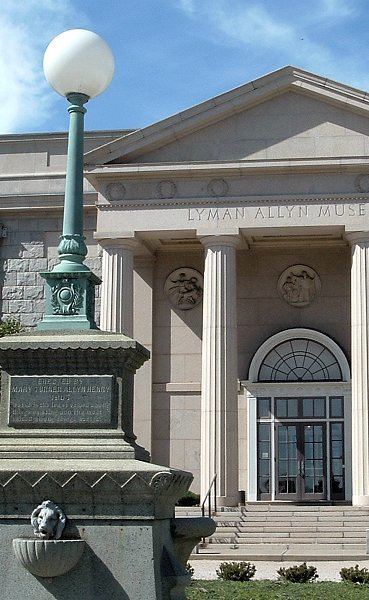Established 1926 Website www.lymanallyn.org | Type Art museum Phone +1 860-443-2545 ext. 129 | |
 | ||
Location 625 Williams Street
New London, Connecticut, United States Address 625 Williams St, New London, CT 06320, USA Hours Open today · 10AM–5PMWednesday10AM–5PMThursday10AM–5PMFriday10AM–5PMSaturday10AM–5PMSunday1–5PMMondayClosedTuesday10AM–5PM Similar Florence Griswold Museum, Fort Trumbull, New London Harbor Li, Ocean Beach Park, Bruce Museum of Arts and Profiles | ||
The lyman allyn art museum new london connecticut
The Lyman Allyn Art Museum was founded in 1926 by Harriet Upson Allyn. It houses the most significant art collection in Southeastern Connecticut, including European and non-Western art as well as American fine and decorative art. Key strengths include 17th-century European works on paper, 19th-century American paintings, and contemporary art. The museum also includes educational programs for audiences ranging from pre-preschoolers to senior citizens.
Contents
- The lyman allyn art museum new london connecticut
- Flatface demo lyman allyn art museum
- History
- Collection
- American art
- References
The museum is located in New London, Connecticut. Also on the museum's campus is the stone Deshon-Allyn House, a Federal style home built in 1829 by Daniel Deshon, sold to Lyman Allyn, and occupied by various members of the Allyn family, including Harriet. The house is listed on the National Register of Historic Places.
Flatface demo lyman allyn art museum
History
The Lyman Allyn Art Museum was founded in 1926 by Harriet Upson Allyn in memory of her father, Lyman Allyn, a wealthy shipping merchant. Miss Allyn's bequest to construct the museum as a place for local citizens to learn about art and culture was made upon her death in 1926. Landscape architect and designer Charles A. Platt was hired by a group of trustees to construct the 32,000 square foot Neoclassical style museum building from local granite.
Collection
The Lyman Allyn is the only museum in the area to offer a comprehensive collection of European art as well as American fine and decorative art. The permanent collection consists of approximately 10,000 objects. Much of this collection was developed by the Museum’s first Director, Winslow Ames, who acquired works dating from the 16th through the 19th centuries. The permanent collection includes the very important graphite Study for Madame Moitessier standing by J.A.D. Ingres as well as works by Frederic Leighton, François Boucher, Nicholas Poussin, Claude Lorrain, Charles LeBrun, and Tiepolo. Featured artists include Rembrandt Peale, Benjamin West, Gilbert Stuart, John Trumbull, Thomas Cole, Frederick Edwin Church, and Albert Bierstadt.
American art
The Museum is best known for its holdings in American art. The Lyman Allyn’s collection of 19th-century American paintings, ranging from the Hudson River School to the Aesthetic Movement and Impressionism, includes many works of art historical significance. Thomas Cole’s Mount Aetna from Taormina (1844), Frederic Edwin Church’s Study for New England Scenery (1850), and John F. Kensett’s oval Bash Bish Falls (1851) are key Hudson River School paintings and Winslow Homer’s tile painting The Shepherdess (1878) is a rare and important example of this American master’s work with the Tile Club. These American works, along with several key European works, are frequently requested for loan exhibitions and for reproduction in scholarly articles and exhibition catalogues.
Complementary to the Museum’s collection of nineteenth-century American paintings, is the sizable collection of eighteenth-century American paintings, works on paper, and decorative arts, most notably silver and furniture. John Singleton Copley’s three studies for The Siege of Gibraltar (c.1785-86), two works by Benjamin West, and Winthrop Chandler’s portrait of Eunice Huntington Devotion and Her Daughter (1772) form the core of this collection. The furniture collection is particularly strong in eighteenth-century New England furniture, including many examples of New London County ’s unique regional variations. New London County furniture has been the focus of a comprehensive exhibition at the Lyman Allyn in 1974 and smaller, focused exhibitions in 1986 and 1999.
